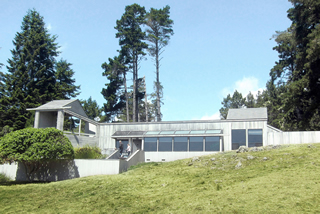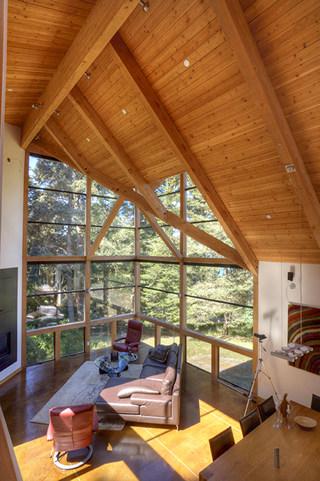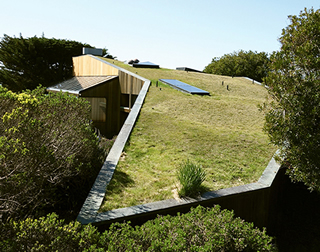Soul-searching by the Sea - Page 5
 |
 |
 |
|
|
Obie Bowman, over the past four decades one of Sea Ranch's most prolific designers, produced in his 'Dragon House,' one of the community's more fanciful houses. Its profile suggests a dragon to its owner, Nikki Yocham, though its tower, with its buttressed base and metal light sconces that look like bells, can also suggest a Mission church campanile.
Inside, the compact structure, which was built in stages as finances allowed starting in the mid-1990s, has multiple split levels, a bedroom loft, and a joyful play of colors and texture.
Proving that the Sea Ranch style continues to produce work at a high level is a 2013 home designed by San Francisco architect Malcolm Davis placed onto a compact, infill site between two existing homes, who has designed eight or nine houses in Sea Ranch as well as remodels.
The home, named the Pelican House, has multiple fenced courtyards, sliding barn-door-like shutters for privacy, a shed-roofed structure, and a rooftop deck. The solar-paneled house is LEED platinum, the highest level for this green rating.
Davis sees his environmentally friendly house as a continuation of Sea Ranch's environmental legacy, but focusing on 21st century concerns. "When Sea Ranch was first built, energy was not a big concern, so there was no concern about insulation," he notes.
He doesn't see the need to work within the Sea Ranch style as a restraint. "I actually like the simplest elements of the vernacular vocabulary, the gable and shed forms. I like simple solutions. I don't feel at a loss that I can't do a tower."
As Sea Ranch prepares to celebrate its 50th year, it is not without worries.
Plans by the owners of the Sea Ranch Lodge to expand the inn into the iconic meadow has some apprehensive.
Sea Ranch itself is almost built out. There are only 486 home sites left, many in the forest.
The association is upgrading its Internet access to provide faster and more consistent high-speed service. That will be a boon—but some think it could be a bane as well, making it easier for high-tech moguls to cyber-commute and driving up home prices.
But, no, Whitaker says, Sea Ranch will never be Carmel.
"It's much more isolated than Carmel, and there are not the amenities around," he says, noting that Sea Ranch has one café, and nearby Gualala has two groceries and a handful of small restaurants—no spas, no fancy shopping.
"People come up here, they're more interested in the natural setting—beaches, certainly, but they don't need a cabana along the beach to make it interesting for them. It's not the kind of resort that has things attached to it to make you spend your money. I think it will always be like that."
Photography: Jim Alinder, Dave Weinstein, Richard Whitaker, Ernie Braun; and courtesy EHDD, Diane Preece




